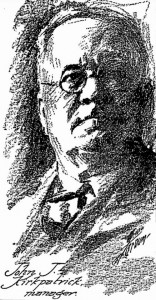by Laurel | February 29th, 2012
26 February 1928
Municipal Organization Has Lowest Rates in the State — Held Up as Example in Representative Shattuck’s Campaign for Lower Rates — Paying off Indebtedness With Its “Dividends”
No sooner had the recent storm broken over the heads of public service companies in this state, particularly the commercial concerns which Chairman Attwin of the public utilities commission described as “hogs,” than all eyes were turned toward an organization which was neither commercialized nor “hogwash.” Thereby the light of publicity was focused upon a comparatively small organization which up to that time had been satisfied to watch complacently inconspicuous developments which seemed inevitable.
Has Sudden publicity
This exposure, which in turn came in for its proper need of attention and praise was nothing other than the gas and electric department of the city of Holyoke, one of the most successfully operated of the municipally owned plants of this type. The reason for the attention it drew was not far afield. It consisted for the most part of the fact that Holyoke enjoys the lowest household light rate ion the state and one of the lowest in the country — only 4 ½ cents a kilowatt hour, as compared with six in Westfield and Springfield, and other higher rates ranging to 12 cents per kilowatt hour at Gloucester. Representative Shattuck, chairman of the ways and means committee of the Legislature, gave Holyoke some first-class publicity in his demand for reduction in rates, in holding it up as an example of what municipal plants could do.
Holyoke took no part in the recent reductions; it stood pat on its 4 ½ cent rate, established as far back as last July without much ado and thought very little of the investigations now under way. This attitude was so strange that it became news and overnight the officers of the Holyoke department were flooded with metropolitan newspapermen as the Smith College campus had been a few weeks previously for an entirely different reason.
These correspondents made inquiries and inevitably reached the same conclusion: the efficiency of the Holyoke department depends upon its manager. They even got representative business men of Holyoke to be quoted to that end, and almost invariably their articles ended: “It’s a fine system, but it depends on the management.”
Not Dependent On One Man
These articles and conclusions brought smiles to the face of John J. Kirkpatrick, the manager. Mr. Kirkpatrick had been head of the department since 1912 and should know what caused the low rate. He is entirely unwilling to assign to himself the entire credit.
“If I were to step out tomorrow,” he says, “this organization would go on, and some time in the future be able to give even lower rates/”
With that he pokes his index finger deeply into his pipe that has gone out while he is talking, takes a match from a big seven-cent package on his desk, lights up, and waits for the next question. As question after question is put to him he foregoes his pipe momentarily , answers at length, and then strikes another match, lights up anew, and gets poised for the next. No hesitation. No digging in records. No head-scratching for elusive figures.
“It’s our business to have everything on tap,” he explains, when you wonder at the mass of information he carries, “and we aim to please. There’s nothing secret about the success of this organization and so many people have asked us about it of late that we have everything ready for them.”
What Causes Low Rates
The secret of low rates at Holyoke seems very simple to Mr. Kirkpatrick. Briefly the principal causes are as follows:
- Absolute relief from taxation, municipal, state and federal.
- Relief from dividend payments.
- Low overhead costs due to central management and elimination of high priced functionaries.
- Ability of the department to borrow money at a low rate of interest (4 ¼ per cent).
- Large number of persons served per “service,” increasing the load factor and cutting down individual cost of conduits, etc.
- Concentration of area served, which has more customers per unit area than many other places in the state.
- Entire freedom from politics (“There is more politics in some private companies I know of than in municipally owned plants.”)
- Obligation by law to sell electricity at a ate which will not yield more than 8 per cent on investment.
- Entire management under civil service assuring its competency and continuance in office over long period of time.
- Constant upkeep of plant. Amount reserved for depreciation must be spent every year for extensions or renewals.
- Increasing use of electricity die in part to low rates enjoyed.
Has Disadvantages, Too
In contrast to these, Mr. Kirkpatrick places certain advantages enjoyed by the commercial companies which the municipal plant has not. Among the chief of these are:
- Ability of private company to raise money by stock issue without necessity of paying it back in fixed installments annually. (This means that the $91,000 paid annually by the Holyoke company to retire bonds could be used for dividend purposes or plant additions.)
- Increased revenue from municipality. (Under private operation the department would have a revenue of $75,000 or more from street lighting, instead of $30,000 derived by selling current to the city at cost. Also an added revenue of $10,000 from the city for other current used.)
- Physical factors such as persons per “service,” concentrated area, etc., would benefit commercial company in the same was as at present they benefit the municipal department.
Tax Exemption is Offset
But if Mr. Kirkpatrick talks about the organization as if he were discussing family affairs, he also knows every phase of his subject. Before going into the history of municipal ownership at Holyoke, let us point out the present status of the company, the entire lack of politics in the organization and other factors which the city enjoys.
The first asset which the company enjoys is complete freedom from taxation, municipal, state and federal. This means that it saves $60,000 annually in municipal taxes and about half that amount in state and federal levies. At the same time the municipality does not lose this sum because it gets its current at cost. This bill in 1927 amounted to $30,000, but if charged at the rates of a commercial company, would have been nearly $75,000, the difference being practically the loss or revenue from taxes.
Apart from that, during 1927 the company paid off $91,000 of its bonded indebtedness, a payment which may be regarded as much of a dividend to all taxpayers, inasmuch as the plant, when fully paid for, will be the property of the city. These payments were made from the revenue of the company and not from appropriations purpose. The city has never appropriated money for the maintenance of the gas and electric department.
Has Competition
The company has more than 16,000 customers in 1927 as compared the 16,652 in 1926, which is considered a normal growth. At the same time, one of the reasons which Holyoke can offer for its low rate is the fact that it serves more persons per “service” than any but three other cities in the country. By a “service” is meant a connection from the main into a house, where this house is an apartment or a private dwelling.
The Holyoke plant is also the only municipally owned plaint in the country which has maintained a low rate in the face of competition, for the Holyoke Water Power Company, a private concern, has the right to see electricity in the same territory in units of not less than 100 horsepower, and does considerable business with mils and shops in the city. It derives its power partly from the Holyoke dam and also from a tie-in with the Turners Falls company. The Holyoke municipal electric department and the Water Power company have a mutual tie-in with each other which either can use in emergencies. The department can also tie in with other commercial companies by getting the right of way from the board of aldermen.
Most of Its Power From Coal
Eighty per cent of the company’s power is derived from coal and only 20 per cent from water power. The steam plant has a capacity of 20,000 horsepower, while the water plant has only 1000 horsepower capacity. The overhead to the company is lower than with smaller commercial companies, electricity costing but one cent a kilowatt at te switchboard.
This low overhead, Mr. Kirkpatrick ascribes in a large measure to the lack of large salaries which in commercial companies are paid to mere functionaries.
No Politics to Bother
One of the arguments usually leveled at the municipal ownership is that politics will raise the cost of operation Mr. Kirkpatrick’s answer to this is that there is more politics in private companies than in those municipally operated.
“We have absolutely no connection with the city politicians,” he says, “we are independent of them and our manager is responsible only to a commission of three men, one appointed every two years for a term of six years. The manager and other heads of the department are under civil service and cannot be removed for mere political reasons. The proof of this is the length of time we have all been in service/”
Have Long Tenure
Mr. Kirkpatrick has been manager since 1912 when he succeeded W. H. Snow, now manager of the New Bedford Edison Gas & Electric Company. Mr. Snow was manager of the department from 1902, when municipal ownership began, until his resignation in 1912. W. H. Darby, superintendent of the electric plant has held that position since the city took it over 25 years ago.
In the gas division conditions are the same, Supt. John J. Fitzgerald having been in that position for 15 years succeeding O. W. Adams, who left at that time to become head of the Brockton company;’s plant. Fitzgerald entered the service of the company as chemist and had 11 years service before being names superintendent.
Not Much Underground
During the years the municipality has operated the plant its number of customers has grown from 273 in 1903 to about 16,000 for 1927 and the miles of wire overhead has increased from 72 to 506. Besides this the department has34.5 miles of underground conduits at presnet, a figure which is regarded as a rather small percentage of the total mileage. This is being steadily increased however.
Adapted from The Springfield Republican.









